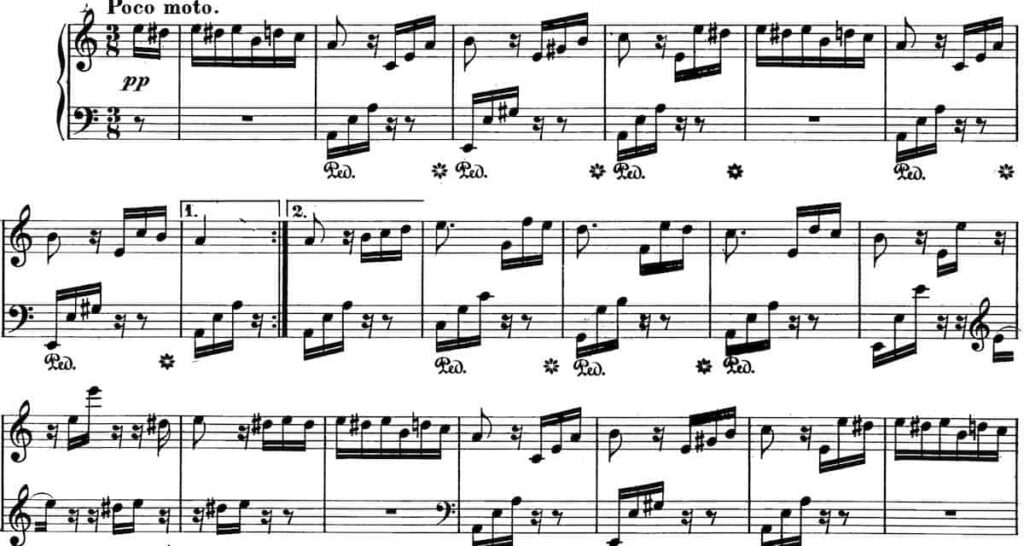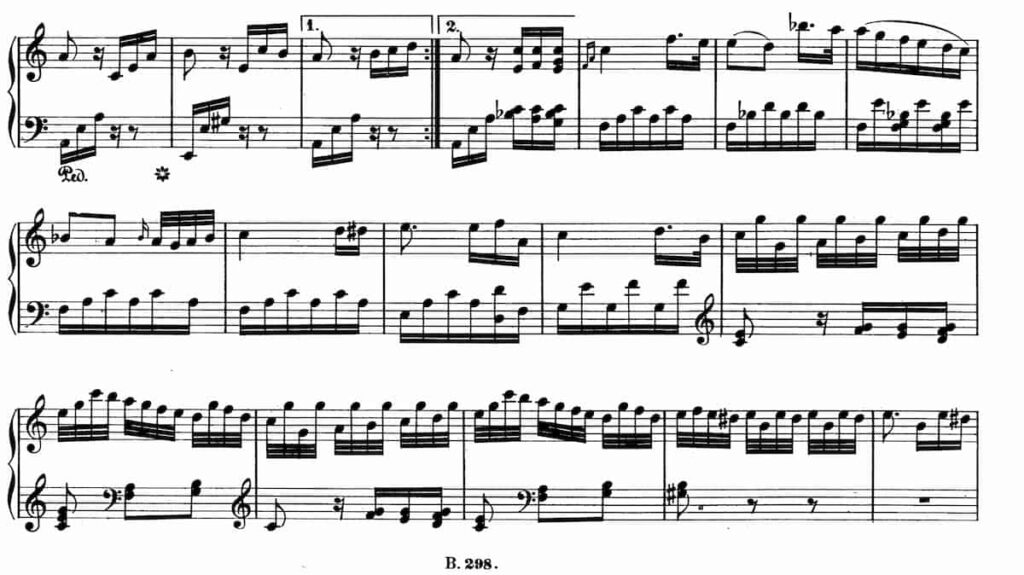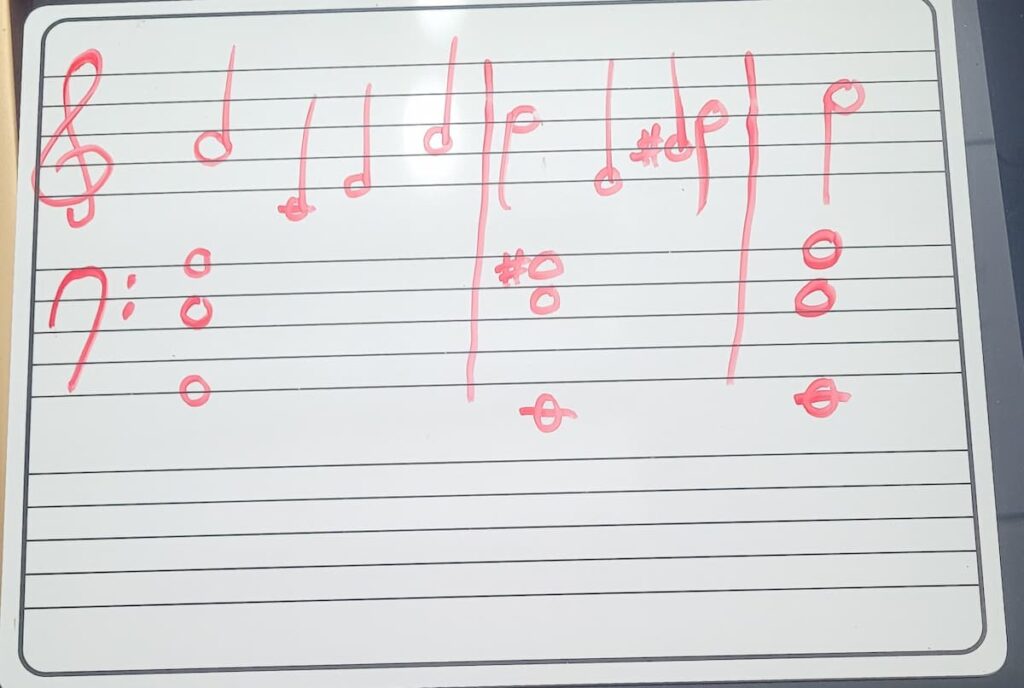As an Amazon Associate I earn from qualifying purchases.
Fur Elise, what more can you say? One of the most famous classical piano pieces in history. With its recognizable half-step melody, it’s something every pianist, novice or advanced, will play at some point. However, what’s the difficulty of the piece? Is Fur Elise hard to play?
Fur Elise is hard to play for most beginner pianists. It features technically challenging sections that also make it challenging for intermediate players. Thankfully, there are simpler arrangements of Fur Elise available for late elementary to intermediate players.
As beautiful as this piece is, it’s not the easiest. In this post, I’d like to share some of the difficult sections, discuss the form a bit, and share some practice strategies you can use to elevate your performance of Fur Elises. Let’s get into it!
Want to Learn Piano?Click Here

How Advanced Is Fur Elise
Depending on which arrangement of Fur Elise you’re playing, the piece is between a grade level 2 to 5. That can be anywhere from moderately easy to incredibly difficult. This also factors into which parts of the piece you play and don’t.
For example, looking at the musical form of Fur Elise, the opening and ending A sections are the easiest. Have a look below:

As you can see in this passage, the right hand goes back and forth on half steps and then outlines A minor and E major chords. So, the tonic and dominant. Eventually, that reaches into some harmonic shifts, rotating between C major, G major, A minor, and E major.
The goal of that for Beethoven was to get to the dominant chord so he could set up A minor and repeat the melody again, the part we are all familiar with.
Not so bad, right? Well, when it comes to Fur Elise being easy, that’s about where it all stops! From then on, things get quite difficult, and it might be a good idea to point those specific sections out to you next.
The 2 Hardest Sections In Fur Elise
Fur Elise has three main difficult sections. The reason I chose these was due to my own experience with the piece, but also what I’ve seen my students find challenging as well.
F Major Section
This is the B section of the piece. Or where the next bit of contrasting material happens. Take a look below.

First off, the piece moves from A minor to F major. Within that are some changes to how the right and left hands both play. More arpeggios are seen, and some flats are introduced. Right away, there’s the challenge of playing the chords located at the 2nd ending. Going between intervals of a 5th and 6th while the left hand is nearby playing 2nds, 3rds, and 4ths.
This is an odd section to play because of the slight contrary motion, plus all working in tighter chords and flats. Some pianists rush through those three chords, while others play them very musically. It depends on what kind of rush and excitement the performer wants to set up for the F major section. Ultimately, these chords need to have clarity and not be mushed.
The rhythm changes a lot with dotted rhythms followed by 16th notes. That’s difficult because it has to be placed appropriately, so the notes don’t crunch together and cause a rushed rhythm.
Then there’s the back and forth between the octave G’s in the right hand that requires a lot of wrist movement (or shaking) to ensure each important note sounds. Some fragments of a C major scale are also present, covering high C and C5 on the piano.
While all this is happening, the left-hand references the intervals of the chords from the 2nd ending. The combination of the hands doing such drastically different things makes this entire section very challenging.
For most students, that’s the most difficult part, especially if they have smaller hands. In a lot of easier versions of Fur Elise, that part is omitted (and sometimes this entire section).
Although this section is the most notey, it requires a gentle touch and dolce character. Playing this musically while also avoiding rushing or slowing down in this passage is crucial.
Pedal Note Section
I like to call this the Pedal Tone section because of the repeated notes. The left hand rotates between a few keys, mostly centered around A minor. While that’s not the difficult part here, it’s the right hand.

Depending on the size of the pianist’s hand, playing some of these chords feels awkward. Wide stretches of a 7th chord, naturals, and other accidentals mixed it. It’s a lot to process! They also have some sustained ones followed by short ones played on the off beats and downbeat. So, coordination and timing are critical here.
That’s not the most challenging part of this section, but the ascending broken triads follow. See below.

Then that’s followed by a descending chromatic scale that can honestly result in twisted-up fingers if the fingering is not precise and accurate. It’s also the most climactic part of the piece and will need to be approached with a ton of diligent practice.
Even if an average pianist gets through the rest of the piece well, this one hiccup can occur if they are not technically sound and listening closely for every note.
Comparing The Easy Version Of Fur Elise Vs. The Hard One
I did refer earlier to easier versions of Fur Elise. There are many arrangements by popular publishers such as Hal Leonard and Faber that allow young students a chance to experience the music without all of the challenges.
Characteristics you’ll find in the easier versions of Fur Elise include:
- Different Key Signatures(often without sharps or flats)
- Simplified melody lines (fewer notes)
- Smaller chords (good for small hands)
- The removal of the F major and Alberti Bass sections
- No repeats (an entirely shortened piece)
For a student, playing something like this is a big accomplishment. However, if your student is more intermediate and can already play some full classical works, these arrangements won’t suffice. Here’s what you can expect to find in the full version of Fur Elise:
- Quicker tempo
- Fully flexed scales in the right hand, including all accidentals
- Multiple harmonies and modulations
- Bigger, more complex chords in the Alberti Bass section
- More specific pedal changes
To help illustrate this better, I’ve included a recording of both the easy and full arrangements of Fur Elise. Compare them both and notice not only the length of time but the complexity of the full version by Beethoven compared to other publishers.
Easy Arrangement:
Full Arrangement:
Practice Strategies For Fur Elise
There are a few ways you can approach Fur Elise by Beethoven so that you can get the best results.
Start with the A sections, highlight them and then play the left hand as blocked chords while the right-hand plays the melody as written. This is a quick way to get the hands together, see how far the hands need to stretch and figure out which fingering patterns can work for the left hand. You also alternate measures of blocked left-hand chords with broken chords.
Below is an illustration of what playing blocked chords in the left hand could look like:

I approach the piece 2 to 4 measures at a time, and not much quicker than this. This strategy can also be taken throughout most of the B section, where the piece goes to F major. If you look closely there, the left hand is playing triads and inversions, occasionally with some smaller intervals worked in.
For the last section with the Pedal Tone, you can play a single note per chord change for the left hand. In most cases, that will be just one note per measure. From there, the right hand can play the melody as written. On the ascending triads, it may be a good idea to block that portion and for the chromatic scale to break it down into smaller four-note phrases.
This helps pianists to map out where potential finger hiccups may occur and work on the quick rotation needed. I like to teach my students to play scales in “windows” or “slideshow” style. This way, they can piece several parts of a longer scalar passage together and then make larger chunks until the entire scale is ready to play.
Final Thoughts
Although Fur Elise is hard to play for pianists earlier in their journey, with some patience and persistence, anyone can play it beautifully. While it’s not as challenging as some of Beethoven’s piano sonatas, it’s still something that needs work.
The key is approaching it with an open mind, thinking about the musical form and how everything ties together. I encourage any pianist looking to learn it to start with some easier versions and then gradually work their way up to the more complex ones.
Hello & thanks for stopping by! I’m a professional concert pianist and piano instructor. In the United States, I’ve given successful performances in several places including New York, Florida, Connecticut, & New Jersey, I have also performed internationally in Italy and made my Carnegie Hall debut in 2014. I enjoy blogging about the piano, the art of performance, general music, current events and the latest in music production.
